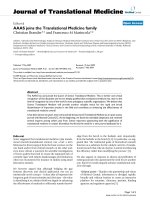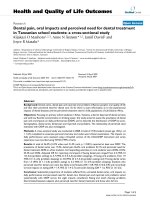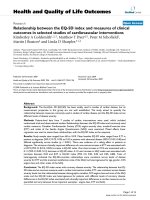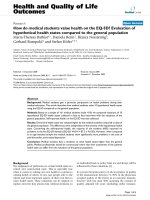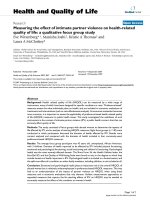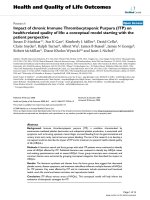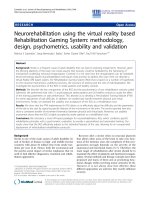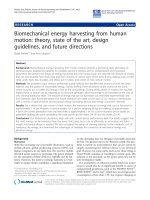báo cáo hóa học:" TMD pain: the effect on health related quality of life and the influence of pain duration" pdf
Bạn đang xem bản rút gọn của tài liệu. Xem và tải ngay bản đầy đủ của tài liệu tại đây (543.59 KB, 8 trang )
Tjakkes et al. Health and Quality of Life Outcomes 2010, 8:46
/>Open Access
RESEARCH
BioMed Central
© 2010 Tjakkes et al; licensee BioMed Central Ltd. This is an Open Access article distributed under the terms of the Creative Commons
Attribution License ( which permits unrestricted use, distribution, and reproduction in
any medium, provided the original work is properly cited.
Research
TMD pain: the effect on health related quality of life
and the influence of pain duration
Geerten-Has E Tjakkes*
1
, Jan-Jaap Reinders
2,3
, Elisabeth M Tenvergert
4
and Boudewijn Stegenga
1
Abstract
Objectives: As impact of literature concerning this subject is scarce, the objectives of this study were to assess
whether the Health Related Quality of Life (HRQoL) is decreased in patients with painful temporomandibular disorders
as compared to the HRQoL in the general population, and to evaluate to what extent pain duration affects HRQoL.
Methods: Data concerning physical and mental health were retrieved from patients with painful temporomandibular
disorders. Assessment tools used were: the Mandibular Function Impairment Questionnaire (MFIQ), the Short-Form-36
(SF-36), the Hospital Anxiety and Depression Schedule (HADS), and the General Health Questionnaire (GHQ). In order to
examine the influence of the duration of pain on HRQoL, the total sample was divided into three different subgroups.
Subgroup 1 consisted of patients with complaints existing less than one year. Patients with complaints from 1 to 3
years were allocated to the second group. The 3rd subgroup included patients with complaints longer than 3 years.
Results: The total sample consisted of 95 patients (90 females and 5 males). On most physical and social functioning
items, groups 2 and 3 scored significantly worse than the general population. On the other hand, none of the groups
differed from the general population when comparing the mental items. Duration of pain was significantly correlated
with SF-36 subscale physical functioning and the mandibular impairment.
Conclusion: Patients with TMD pain less than one year score better than compared to the population norm. With a
longer duration of pain, mental health scores and role limitations due to emotional problems do not appear to be
seriously affected by reduced physical health, while social functioning appears to be considerably affected.
Background
Temporomandibular disorders (TMDs) comprise a group
of disorders that affect the temporomandibular joint
(TMJ), the masticatory muscles, or both. TMDs involve
musculoskeletal pain, disturbances in the mandibular
movement patterns, and/or impairment in functional
movement [1]. Pain is the main characteristic of most
TMDs and also the main reason for patients to seek treat-
ment [2]. Many TMDs should be considered chronic pain
conditions, since they show lot of similarities [3]. Psycho-
logical factors have been implicated in the initiation as
well in the perpetuation of several TMDs [4]. Stress,
somatic distress, and depression may be potential etiolog-
ical risk factors for TMD-related pain [5]. When the
duration of pain increases, psychological factors may
become more obvious and prominent. Even after a
decrease of the somatosensory input, suffering and pain
behaviour may continue and even increase [6].
It is generally accepted that quality of life is negatively
affected by chronic pain [7,8]. The impact of TMDs (and
other types of orofacial pain) on Health Related Quality
of Life (HRQoL), however, has scarcely been described.
Recently, Naito et al. conducted a systematic review on
oral health status and health-related quality of life [9].
They found only one study concerning TMDs. In this
study, Reisine and Weber [10] observed a sample of 30
patients with temporomandibular disorders, during 6
months. Different aspects of HRQoL were investigated
e.g. anxiety, perceptions and social functioning. It was
found that while the pain decreased over time, oral and
functional aspects did not improve significantly within
the same period of time. This result may be due to a
slower response of other parameters to treatment in con-
trast to a relatively rapid response of pain. Furthermore,
the authors found relatively poor ratings of well-being
* Correspondence:
1
Department of Oral and Maxillofacial Surgery, University Medical Center
Groningen University of Groningen, Groningen, PO Box 30.001, 9700 RB, The
Netherlands
Full list of author information is available at the end of the article
Tjakkes et al. Health and Quality of Life Outcomes 2010, 8:46
/>Page 2 of 8
and high levels of anxiety, suggesting that TMD patients
are characterized by relatively negative psychological
states, and that when pain persist (even when dimin-
ished) functional aspects do not improve.
Murray et al. [11] described the HRQoL, as measured
with the Oral Health Impact Profile (OHIP), of patients
referred to a craniofacial pain unit because of TMD and
facial pain. With regard to pain-related disability and
HRQoL, 29.7% of the sample reported a frequently dis-
turbed sleep as a consequence of their oral conditions,
and 36.4% reported feelings of depression. Different
researchers have found a larger impairment of the oral
HRQoL in TMD patients compared with healthy popula-
tion, using the OHIP [12,13].
LeResche et al. [14] studied the facial expression as well
as states of anxiety, depression, somatization and daily
stress in a group of TMD pain patients, subgrouped into a
chronic and non-chronic category. With regard to these
four aspects of HRQoL, no differences were found
between a group of patients that perceived pain for the
first time within the last two months (non chronic group)
and a group that suffered from pain for over 6 months
(chronic group).
It is not clear whether and, if so, how (chronic) pain
related to TMDs influences HRQoL, and whether pain
duration is of influence. It may be hypothesized that
when pain has just begun, this will mainly affect physical
factors such as physical functioning. When the pain lasts
for a longer period, and treatment so far has failed to
relieve the pain, it may start to have more impact on the
emotional behaviour, social factors and HRQoL. How-
ever, whether this is the case is yet not clear. Information
concerning the influence of pain and its persistence on
HRQoL may guide (the emphasis of ) treatment in these
patients. Therefore, the aims of this study were to assess
whether the HRQoL is decreased in orofacial pain
patients as compared to the general population, and to
study the effect of duration of pain on HRQoL.
Methods and materials
Sample
Patients were recruited from the department of Oral and
Maxillofacial Surgery of the University Medical Center
Groningen. The group consisted of 95 patients consecu-
tively consulting the TMD/Orofacial Pain section for
their orofacial pain problems. The inclusion criteria were
age over 16 years, no language barrier, and the presence
of a painful temporomandibular disorder as classified
according to the RDC/TMD [15,16]. From the axis II
information, the duration and impact of the pain were
assessed. The influence of the duration of pain on
HRQoL was examined by two means. Firstly, the total
sample was divided into three different subgroups. Sub-
group 1 consisted of patients with complaints existing
less than one year. Patients with complaints from 1 to 3
years were allocated to the second group. The 3
rd
sub-
group consisted of patients with complaints longer than 3
years. Secondly, the influence of the duration of pain was
studied using results of the total sample in regression
analysis. During their first visit to the clinic, patients were
informed about the study and the content of the ques-
tionnaires. When patients were willing to participate,
they were requested to fill in an informed consent.
Quality of life has been described by the World Health
Organisation as " an individual's perception of their
position in life in the context of the culture and value sys-
tem of which they live with the relation to their goals,
expectations, standards and concerns." This concept
incorporates different aspects of individuals, including
physical health, psychological state, level of indepen-
dence, social relationships, personal beliefs and their rela-
tionship to salient features of the environment [17].
Assessment and Instruments
During the second visit to the clinic, patients were
instructed how to complete the questionnaires. Subse-
quently, patients were left alone to complete the ques-
tionnaires. When necessary, unclear test items could be
clarified by the interviewer. Only Dutch versions of the
questionnaires were used.
HRQoL was measured by the following instruments
SF-36
The Medical Outcome Short Form Health Survey, a 36
item health survey, was used to assess the patients'
HRQoL [18]. It includes eight health concepts: physical
functioning (PF, measuring the physical activities), role
limitations due to physical health problems (RP, measur-
ing the effect of the physical health on work and daily
activities), bodily pain (BP), general health (GH) percep-
tions, vitality (VT, measuring energy/fatigue), social
functioning (SF), role limitations due to personal or emo-
tional problems (RE measuring the effect of the emotions
on work and daily activities) and general mental health
(MH including anxiety and depression). The scores on
every subscale range from 0-100, with higher scores indi-
cating better health states. Reference values were used to
compare the results of the group in question. The refer-
ence values were taken from a Dutch study, which con-
sisted of a random Dutch sample of 1742 persons, which
is used as the reference group [19]. In this study the mean
values for each subscale were for PF 83.0 (sd 22.8), RP
76.4 (sd 36.3), BP 74.9 (sd 23.4), GH 70.7 (sd 20.7) VT
68.8 (sd 19.3), SF 84.0 (sd 22.4), RE 82.3 (sd 32.9), MH
76.8 (sd 17.4) [19].
MFIQ
The Mandibular Function Impairment Questionnaire
was used to obtain information about the function
Tjakkes et al. Health and Quality of Life Outcomes 2010, 8:46
/>Page 3 of 8
impairment of the jaw. It was developed to provide for a
tool, additional to the clinical assessment, for assessment
of function impairment in the patients own value system
[20]. It comprises 17 items, concerning mandibular func-
tions e.g. speaking and eating different types of food. A
functional impairment rating score (FIRS) can be
retrieved. This is a score ranging from 0 (no function
impairment) up to 5 (indicating severe function impair-
ment) [20].
HADS
To assess depression and anxiety in a hospital setting, the
HADS was used [21]. To screen for anxiety (HADS-A)
the odd items were used. For the screening of depression
(HADS-D), the even items of questionnaire were used.
On each subscale, scores up to 7 indicate no signs of anx-
iety or depression, scores between 8 and 10 suggest prob-
able anxiety or depression, and scores over 10 indicate the
presence of anxiety or depression, respectively [21].
GHQ-28
The general health questionnaire was used to assess dif-
ferent types of psychiatric distress. It is a 28 item list
which can be divided into four different subscales:
somatic symptoms (GHQA), anxiety and insomnia
(GHQB), social dysfunction (GHQC) and severe depres-
sion (GHQD) [22]. The reference values were for GHQA
6.2, GHQB 5.8, GHQC 7.0, GHQD 1.6 and were retrieved
from a general Dutch population of 485 persons [23].
Sample size calculation
To estimate the a priori sample size, an effect size of 0.4
was chosen. By convention this effect size is considered as
a moderate effect size. Sample was calculated on an
ANOVA with the parameters α, β, number of groups and
effect size. α was set at 5%, β at 10%, number of groups 3,
resulting in a critical F of 3.10931. The total calculated
sample was 84. To account for possible dropouts, sample
size was about 10% increased to 95.
Statistical analysis
Descriptive statistics were performed to summarize sam-
ple characteristics. Data were tested for normality using
the Kolmogorov-Smirnov test. By means of one sample
T-tests, the HRQoL scores of the patients were compared
to those of a general population. To test mean differences
in HRQoL among subgroups, one-way ANOVA was car-
ried out, followed by Scheffe's post hoc multiple compari-
son test in case of a significant result. In order to study
the association between the duration of pain and the
scores on the different SF-36 subscales, HADS scores,
GHQ-28 scores, and MFIQ score, respectively, Pearson
correlation coefficients were calculated. Outlier analysis
with scatter plots was performed to look for possible dif-
ference in scores between female and male participants.
Data from the total sample was analysed in a regression
analysis. Data were analyzed using SPSS 14 (SPSS Inc,
USA). The level of significance was set at 0.05. This study
was approved by the Medical Ethical Committee of the
University Medical Center Groningen.
Results
Patients
In total 95 patients (90 females and 5 males) provided
their consent to participate in the study. Their average
age was 40.3 yrs (sd 13.1, ranging from 17-69). According
to the RDC/TMD criteria, patients were diagnosed with a
group I diagnosis (myofascial pain), a group II diagnosis
(disc displacement) a group III (arthralgia, osteoarthritis
and osteoarthrosis). A group I diagnosis was established
in 31.9%; a group II diagnosis in 4.4% and a group III in
35.2%. A combined diagnosis was made in 28.7% of all
cases (in 7.8% group I and II, in 17.6% group I and III, and
in 3.3% group II and III were combined). Furthermore,
the participants of the 3 subgroups based on pain dura-
tion were calculated: subgroup 1 (pain present for less
than one year) consisted of 15 patients (14 females; 1
male, mean age 37.7 yrs, sd 14.4, range 17-69), subgroup 2
(1-3 years pain duration) consisted of 16 patients (13
females, 3 males; mean age 37.5 yrs, sd 14.1, range 20-68),
and subgroup 3 (more than 3 years of pain) consisted of
64 patients (63 females, 1 male; mean age 41.6 yrs, sd
12.5, range 17-67). The distribution of the diagnoses,
medication use and coinciding chronic pain diseases
among the three groups is listed in Table 1.
Effects of pain duration: Three groups
Results compared with reference values
Table 2 shows the mean SF-36 and GHQ scores for the
three subgroups. The first ("relatively acute") subgroup
scored better on the subscale physical functioning and
worse on subscales general health and vitality than the
general population, but on the other subscales this sub-
group and the general population revealed comparable
scores.
Compared with the general population, the second sub-
group scored worse on four subscales (bodily pain, vital-
ity, general health and social functioning) and the third
subgroup scored worse on six SF-36 subscales (bodily
pain, vitality, general health, social functioning, physical
functioning and role emotional).
In the first and second group, scores on the GHQ scales
did not significantly differ from scores in the general pop-
ulation. The third group showed more impairment in
somatic symptoms and showed higher social dysfunction,
with worse scores on GHQA and the GHQC, compared
to those obtained from the general population.
Comparisons between groups
No differences were found in age between the three
groups. Statistically significant differences were found
Tjakkes et al. Health and Quality of Life Outcomes 2010, 8:46
/>Page 4 of 8
between groups 1 and 3 with regard to the SF-36 subscore
on the scales physical functioning and bodily pain (i.e.
scores were better in group 1), but not between groups 2
and 3. Other SF-36 scores did not differ significantly
between the three groups.
The third group showed more somatic problems as well
as a higher level of social dysfunction compared to the
first group, as GHQA and GHQC scales revealed signifi-
cant differences between these groups.
The patients' impairment in mandibular function, as
assessed with the MFIQ and expressed in the function
impairment rating scale (FIRS), was 2.4 (sd 1.1) for the
first group, 2.6 (sd 2.0) for the second group, and 3.3 (sd
1.6) for the third group, indicating moderate impairment
in these three subgroups (Table 2). No significant differ-
ences between the three groups were found in the FIRS.
Both HADSA and HADSD scores were worse in groups
2 and 3 as compared to group 1 (Table 3). In addition, the
HADSD score in group 2 was worse than in group 3.
Effects of pain duration: total sample
The social, psychological and part of the physical mea-
sures did not show significant correlation with pain dura-
tion. Of all calculated correlations, the SF-36 subscale
bodily pain and the Function Impairment Rating Scale
(FIRS) were significantly correlated with the duration of
pain.
Table 1: Distribution of age, RDC diagnoses medication usage and coinciding chronic pain disorders among the three
subgroups.
Group
123
Total 15 16 64
Female/male 1/14 3/13 1/63
Age (sd) 37.6 (14.4) 37.5 (14.1) 41.6 (12.5)
RDC/TMD diagnosis: nnn
Group I 3 8 20
Group II 0 0 3
Group III 5 7 24
Group I + group II 0 0 4
Group I + group III 5 0 12
Group II + group III 2 1 1
Analgesic usage
Paracetamol 0 1 7
NSAID 1 0 3
Tricyclic antidepressant 1 5 6
Tricyclic antidepressant +
paracetamol
100
Tricyclic antidepressant +
NSAID
002
NSAID + opioid 0 0 2
Other chronic pain condition
Rheumatoid arthritis 0 2 1
Hernia 0 0 1
Back pain 0 0 1
Group 1: Myofascial pain
Group 2: Disc displacement
Group 3: Arthralgia/osteoarthritis/osteoarthrosis
NSAID: Non-steroidal anti-inflammatory drug
Tjakkes et al. Health and Quality of Life Outcomes 2010, 8:46
/>Page 5 of 8
Outlier analysis revealed no differences on the sub-
scales in any of the assessed subscales between female
and male patients.
Discussion
In this study we examined whether the duration of pain in
TMD patients seeking treatment affects the HRQoL and
psychological well-being. When managing these patients,
psychological assessment may lead the clinician to multi-
dimensional, biobehavioral therapy modalities rather
than to somatically based therapies [2]. Also, TMD
patients classified into different cognitive-behavioural
profiles seem to respond differently when the same treat-
ment is offered [24]. Thus, not only the physical but also
the psychological status may influence the treatment out-
come.
The duration of pain is thought to have a significant
impact on a patient's psychological status (Figure 1) [6].
To provide more insight into the effect of duration of pain
complaints, we compared patients with relatively acute
pain (less than 1 year) and patients with chronic pain (1-3
years and > 3 years, respectively). A striking finding was
Table 2: SF-36 and GHQ scores in three groups of orofacial pain patients and reference values.
reference 1 2 3
Scale Mean (SD) Mean (SD)
n = 15
Mean (SD)
n = 16
Mean (SD)
n = 64
SF-36 PF
a
83.0 (22.8) 92.1 (8.1)*
3
74.2 (33.1) 72.3 (25.7)*
1
SF-36 RP
a
76.4 (36.3) 54.2 (38.1) 71.2 (3.6)
3
41.2 (39.7)*
2
SF-36 BP
a
74.9 (23.4) 66.1 (20.4)
3
53.2 (27.5)* 48.5 (19.7)*
1
SF-36 GH
a
70.7 (20.7) 53.0 (23.4)* 55.8 (18.7)* 54.4 (20.6)*
SF-36 VT
a
68.8 (19.3) 52.9 (14.9)* 49.3 (21.6)* 55.2 (19.4)*
SF-36 SF
a
84.0 (22.4) 74.0 (22.9) 66.0 (29.2)* 66.7 (23.4)*
SF-36 RE
a
82.3 (32.9) 66.7 (31.8) 81.0 (55.0) 80.9 (34.1)
SF-36 MH
a
76.8 (17.4) 66.4 (12.5) 60.6 (17.9)
3
73.2 (13.0)
2
GHQA
b
6.2 6.7 (4.1) 6.3 (4.1) 8.2 (4.0)*
GHQB
b
5.8 2.8 (2.1)
2
7.5 (3.6)
1
5.9 (4.4)
GHQC
b
7.0 6.6 (1.8)
3
8.2 (3.3) 8.3 (2.3)*
1
GHQD
b
1.6 0.8 (1.8) 2.7 (3.5) 1.9 (3.0)
Values in mean (standard deviation, * p < 0.05 from reference values, in superscript the group to which the value is statistically different;
reference values from
a
Aaronson et al.[19],
b
Koeter & Ormel [23].
(PF, physical functioning; RP, Role limitations physical; BP, bodily pain; GH, general health; VT, vitality; SF, social functioning; RE, role
limitations emotional; MH, mental health; SD, standard deviation; GHQA, somatic symptoms; GHQB, anxiety and insomnia; GHQC, social
dysfunction; GHQD, severe depression; P, P-value)
1. group with complaints of one year or shorter
2. group with complaints within 1 and 3 years
3. group with complaints longer than 3 years.
Table 3: FIRS, HADSA and HADSD scores (standard deviation) for three groups.
Group
123
score
FIRS (sd) 2.4 (1.1) 2.6 (2.0) 3.3 (1.6)
HADS A (sd) 3.3 (1.8)
2,3
6.4 (4.1)
1
5.0 (3.6)
1
HADS D (sd) 1.6 (1.1)
2,3
6.2 (4.2)
1,3
3.5 (3.1)
1,2
1.: group with complaints of one year or shorter
2.: group with complaints within 1 and 3 years
3.: group with complaints longer than 3 years.
(FIRS; functional impairment rating score, HADSA; anxiety, HADSD; depression. In superscript the group to which the value is statistically
different)
Tjakkes et al. Health and Quality of Life Outcomes 2010, 8:46
/>Page 6 of 8
that in all three subgroups the SF-36 scores of the scales
role emotional and mental health did not differ signifi-
cantly from the reference values. It may be, that patients
with a longer experience of complaints tend to get used to
their pain and symptoms and incorporate them as a part
of their life, thereby leaving their mental health less
affected.
The first group did score significantly higher ("better")
on the scale "physical functioning", compared to the pop-
ulation norm. This finding could be explained by possible
underestimation of the physical situation, when patients
visit a hospital and are allocated to a study group that
answers questions about health. Patients with pain or
function problems that have arisen within the last year,
may tend to focus on these problems in an opposite man-
ner than patients who have a longer experience with these
problems. In addition, the scale bodily pain was not sig-
nificantly different from the reference value. Because of
the relatively short existence of pain, patients may under-
estimate or underrate the consequences of their disorders
on the measured scales. They may be convinced that
(pain) symptoms will be transient and, therefore, patients
will not allow them to affect the physical items. Patients
may also feel the need to convince the doctor that the
symptoms are purely physical, and want to display that
statement in the answers of the subscales.
By contrast, on SF-36 physical health items ("bodily
pain", "general health" and "vitality") the second and third
group scored significantly worse than reference values. In
addition, in the third group the items physical functioning
and role physical were also worse than reference values.
This physical impairment was confirmed by the FIRS
scores, indicating moderate function impairment. So the
mandibular function was lowered in all three groups. The
GHQA score, which represents the somatic general
health, is significantly lower ("worse") in the third group,
which is in accordance with the scores on the SF-36. With
significantly lower scores on the physical scales of the SF-
36, the second and third subgroup did not score signifi-
cantly lower on the mental scales.
Between the different pain duration groups, statistically
significant differences were found only on a few scales.
Comparing "better" scores from the first group with
"worse" scores from the third group, leads in the physical
functioning scale to a significant difference between those
scores. Although the HADS scores are interpreted using
cut-off points, it is striking that the depression scale
(HADSD) in group 2 is not only higher compared to
group 1, but also compared to group 3. Patients who
experience complaints for a short time may not be seri-
ously affected, but when pain persists, psychological dis-
tress will be more pronounced. Later, when patients are
used to the pain or when they are sufficiently reassured
about their health status, the psychological distress will
return to lower values again. This is in accordance with
the score on the mental health item of the SF-36, which is
better in the third group compared to the second group.
According to our findings, it may seem that patients
with a shorter duration of pain seem to underrate their
physical impairment or at least do not consider it to be
relevantly impaired, as the scores are "better" compared
with a healthy reference group. Patients with longer last-
ing pain at least longer than one year, have more pro-
nounced physical problems. The role limitations due to
emotional problems or the mental health seem to be
hardly affected, however. It has been suggested that psy-
chological functioning is merely related to patients'
beliefs and coping strategies rather than to the physical
impairment [25]. On the other hand, the social function-
ing scale in the SF-36 as well as the GHQC score suggest
that social functioning is affected in the third group. This
may be explained by role limitations due to physical limi-
tations, which in turn may be the result of the actual dis-
order.
In addition to the analysis with three subgroups, we cal-
culated Pearson correlation coefficients with data from
all patients. This revealed a significant correlation
between the whole range duration of pain with the sub-
scale physical functioning and the mandibular impair-
ment (FIRS). So with a longer duration of pain, the
somatic well-being is considered worse. It remains
unclear whether the physical discomfort has worsened
during its existence or whether the discomfort is only
rated worse due to its longer existence. Other subscales
and other scores did not show significant correlation with
duration of pain, which may be explained by a large range
of duration of pain in contrast to the smaller scale range
of the scores on other subscales and the other question-
naires.
One factor that may be of influence on the results is the
age. In our sample, no difference was found between the
three groups. Besides TMD pain, other pain condition
could play a role in HRQoL. Of the studied sample totally
five had an accompanying chronic condition. In the sec-
Figure 1 The effect of duration of symptoms on psychosocial fac-
tors. From Okeson [6]. Used with permission.
Tjakkes et al. Health and Quality of Life Outcomes 2010, 8:46
/>Page 7 of 8
ond group, two suffered also from rheumatoid arthritis.
In the third group, one patient suffered from rheumatoid
arthritis, one from hernia and one from low back pain.
These conditions could have influenced the question-
naire outcomes, although the number of patients is a
slight minority compared to the total sample size, there-
fore we argued this to be of negligible influence.
A limitation of this study could be the large female pre-
dominance, which is than in the general population,
which may hamper the generalizability of the results.
However, a predominance of female gender in TMDs is
also found in epidemiological research [26]. In addition,
more female than male patients seek treatment for their
pain problems, leading to an increasing female predomi-
nance in specialist centers, with a female:male ratio rang-
ing from 2:1 to 9:1 [27]. In addition, outlier analysis (to
explore possible differences in measurements in our sam-
ple between male and female patients) revealed no outli-
ers in the assessed subscales. We thus consider sex
difference in our sample to be of minor influence and we
therefore decided to include both male and female in the
total analysis.
Conclusion
In patients with chronic pain conditions, such as most
TMD pains, it has been demonstrated that psychological
factors are better predictors of treatment outcome on the
long-term than physical findings are [2,28]. When TMD
patients with pain less than one year are compared to a
reference population, it was found that these patients
scored better on physical functioning. However, we found
that patients with longer lasting problems have more pro-
nounced physical problems and limitations and that these
limitations have impact on social functioning in this
group. The mental health and role limitations due to
emotional problems do not seem to be seriously affected
by reduced physical activities. Especially in cases of lon-
ger duration of pain, where initial treatment has failed to
relieve the pain, the social functioning may be consider-
ably affected and should therefore be taken into account
when managing these conditions.
Competing interests
The authors declare that they have no competing interests.
Authors' contributions
GHET conceptualized and designed the study, acquired the data and partici-
pated in data analysis, and drafted the manuscript;
JJR, ETV, BS contributed in data analysis and participated in revising the manu-
script critically for important intellectual content.
All authors read and approved the final manuscript.
Author Details
1
Department of Oral and Maxillofacial Surgery, University Medical Center
Groningen University of Groningen, Groningen, PO Box 30.001, 9700 RB, The
Netherlands,
2
Center for Dentistry and Oral Hygiene, Department of Oral
Health Care and Clinical Epidemiology, University Medical Center Groningen,
University of Groningen, Groningen, 9700 VB, The Netherlands,
3
Research
Innovation Group in Health Care and Nursing, Hanze University Groningen,
University of Applied Sciences, Groningen, PO Box 275, 9700 VB, The
Netherlands and
4
Office for Medical Technology Assessment, University
Medical Center Groningen, University of Groningen, Groningen, PO Box 30.001,
9700 RB, The Netherlands
References
1. Stegenga B: Temporomandibular joint osteoarthrosis and internal
derangement. Diagnostic and therapeutic outcome assessment. In
PhD Thesis University of Groningen; Faculty of Medicine; 1991.
2. Dworkin SF: Psychological and psychosocial assessment. In
Temporomandibular disorders: an evidence-based approach to diagnosis
and treatment Edited by: Laskin DM, Greene CS, Hylander WL. Chigago:
Quintessence publishing. Co., Inc; 2006:203-228.
3. Dworkin SF, Massoth DL: Temporomandibular disorders and chronic
pain: disease or illness? J Prosth Dent 1994, 712:29-38.
4. Yap AUJ, Tan KBC, Chua EK, Tan HH: Depression and somatization in
patients with temporomandibular disorders. J Prost Dent 2002,
88:479-484.
5. Zakrzewska JM, Harrison SH: Assessment and management of orofacial
pain. Pain research and clinical management Amsterdam. Elsevier; 2002.
6. Okeson JP: Bell's orofacial pains Sixth edition. Chigago: Quintessence
Publishing; 2005.
7. Kempen GI, Ormel J, Brilman EI, Relyveld J: Adaptive responses among
Dutch elderly: the impact of eight chronic medical conditions on
health-related quality of life. Am J Public Health 1997, 87:34-44.
8. Schlenk EA, Erlen JA, Dunbar-Jacob J, McDowell J, Engberg S, Sereika SM:
Health related quality of life in chronic disorders: a comparison across
studies using the MOS SF-36. Qual Life Res 1998, 7:57-65.
9. Naito M, Yuasa H, Nomara Y, Nakayama T, Hamajima N, Hanada N: Oral
health status and health-related quality of life: a systematic review. J
Oral Sci 2006, 48:1-7.
10. Reisine ST, Weber J: The effects of temporomandibular joint disorders
on patients' quality of life. Comm Dent Health 1989, 6:257-270.
11. Murray H, Locker D, Mock D, Tenenbaum HC: Pain and the quality of life
in patients referred to a craniofacial pain unit. J Orofac Pain 1996,
10:316-323.
12. Segu M, Collesano V, Lobbia S, Rezzani C: Cross-cultural validation of a
short form of the Oral Health Impact Profile for temporomandibular
disorders. Comm Dent Oral Epid 2005, 33:123-130.
13. John MT, Reissman DR, Schierz O: Oral health-related quality of life in
patients with temporomandibular disorders. J Orofac Pain 2007,
21:46-54.
14. LeResche L, Dworkin DF, Wilson L, Ehrlich KJ: Effect of
temporomandibular disorder pain duration on facial expressions and
verbal report. Pain 1992, 51:289-295.
15. Dworkin S, LeResche L: Research diagnostic criteria for
temporomandibular disorders: review, criteria, examinations and
specifications, critique. J Craniomand Disord Fac Oral Pain 1992,
6:301-355.
16. Lobbezoo F, Van Selms MK, John MT, Huggins K, Ohrbach R, Visscher CM,
Zaag J Van Der, Meulen MJ Van Der, Naeije M, Dworkin SF: Use of the
Research Diagnostic Criteria for Temporomandibular Disorders for
multinational research: translation efforts and reliability assessments
in The Netherlands. J Orofac Pain 2005, 4:301-308.
17. The World Health Organization quality of life assessment (WHOQOL):
position paper from the World Health Organization. Soc Sci Med 1995,
10:1403-1409.
18. Hays RD, Sherbourne CD, Mazel RM: The RAND 36-Item Health Survey
1.0. Health Econ 1993, 2:217-227.
19. Aaronson NK, Muller M, Cohen PDA, Essink-Bot ML, Fekkes M, Sanderman
R, Sprangers MAG, Te Velde A, Verrips E: Translation, validation and
norming of the Dutch language version of the SF-36 health survey in
community and chronic disease populations. J Clin Epidemiol 1998,
51:1055-1068.
20. Stegenga B, De Bont LG, De Leeuw R, Boering G: Assessment of
mandibular function impairment associated with temporomandibular
joint osteoarthrosis and internal derangement. J Orofac Pain 1993,
2:183-195.
21. Zigmond AS, Snaith RP: The Hospital Anxiety and Depression Scale.
Acta Psychiatr Scan 1983, 67:361-370.
Received: 8 July 2009 Accepted: 2 May 2010
Published: 2 May 2010
This article is available from: 2010 Tjakkes et al; licensee BioMed Central Ltd. This is an Open Access article distributed under the terms of the Creative Commons Attribution License ( which permits unrestricted use, distribution, and reproduction in any medium, provided the original work is properly cited.Health and Qu ality of Life Out comes 2010, 8:46
Tjakkes et al. Health and Quality of Life Outcomes 2010, 8:46
/>Page 8 of 8
22. Goldberg DP, Hillier VF: A scaled version of the General Health
Questionnaire. Psychol Med 1979, 9:139-145.
23. Koeter MWJ, Ormel J: General Health Questionnaire, Nederlandse bewerking;
handleiding Lisse: Swets Test services; 1991.
24. Dahlstrom L, Widmark G, Carlsson SG: Cognitive-behavioural profiles
among different categories of orofacial pain patients: diagnostic and
treatment implications. Eur J Oral Sci 1997, 105:377-383.
25. Turner JA, Dworkin SF, Mancl L, Huggins KH, Truelove E: The roles of
beliefs, catastrophizing, and coping in the functioning of patients with
temporomandibular disorder. Pain 2001, 92:41-51.
26. LeResche L: Epidemiology of temporomandibular disorders:
implications for the investigation of etiological factors. Crit Rev Oral Biol
1997, 8:291-305.
27. Bush FM, Harkins SW, Harrington WG, Price DD: Analysis of gender
effects on pain perception and symptom presentation in
tempormandibular pain. Pain 1993, 53:73-80.
28. Turk DC, Okifuji A: Psychological factors in chronic pain: evolution and
revolution. J Consult Clin Psychol 2002, 70:678-690.
doi: 10.1186/1477-7525-8-46
Cite this article as: Tjakkes et al., TMD pain: the effect on health related qual-
ity of life and the influence of pain duration Health and Quality of Life Out-
comes 2010, 8:46

